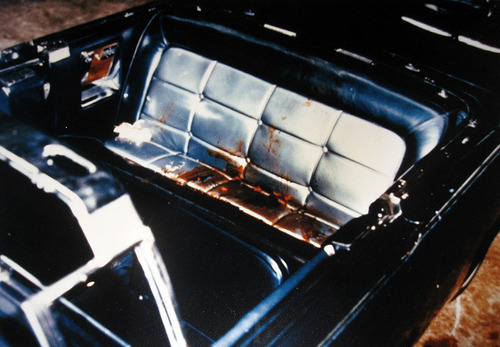In May of this year, the Dallas Museum of Art will mount Hotel Texas, an exhibition that brings together the artworks seen in the last hotel room of the late John F. Kennedy. These are the sculptures, the paintings—the sun-burnished nudes and the dreary snowscapes—as seen by the gray-green eyes of the President just hours before his violent death in the motorcade. Each individual piece's quiet observance of Kennedy's final moments is its God-given purpose in this exhibit—an art mausoleum. These works, after all, were not chosen for their dynamism, but for their inertia—as halcyon visual valium for the great American super-class. Alone, as objets d'art, they are important and broad and uninteresting, but as talismans of celebrity death, they are equal parts sacred and ghoulish-profane.
Are we—when viewing, say, a Picasso bronze—exhorted to picture, also, the cubist gore of JFK’s skull, with its newly-abstracted, exploded lines? To imagine the moment of impact on the handsome President's suited, supra-scapular expanse as the scattershot of a gore-tinted Jackson Pollock? The small, pale hands of JFK's wife, Jacqueline, in this picture perform the architect’s task of shaping the cranial fallout into something resembling a head, and her kid gloves—once as white as the cottoned hands of a museum archivist—are immersed in hematic color, the animal red of a Rothko painting. As JG Ballard once suggested to Hans-Ulrich Obrist that JFK's death had become an accepted example of Pop Art in extremis—of quasi-Warholian Death and Destruction, electric chair and Jaguar crash—so this is a Pop Art show: as Pop as Jackie's silkscreen, or as Kennedy's Broadway showtune records.

Second (smaller) Bedroom, Suite 850, Hotel Texas, Fort Worth, Friday, November 22, 1963, Thomas Eakins, Swimming (formerly The Swimming Hole), Charles M. Russell, Lost in a Snowstorm – We Are Friends (formerly Meeting in a Blizzard), Owen Day/Danna Day Henderson Papers, Photo by Byron Scott.
———
An aside:
The catalogue listings and Kennedy's autopsy papers even assume a structural kinship—here the location, and there the embellishment; here the numeric details, thus:
The Master Bedroom, which was designated as Jacqueline Kennedy’s bedroom, was adorned with Impressionist masterworks, per her well-known affinity for the genre. The room included Summer Day in the Park, 1918–23, by Maurice Brazil Prendergast; Vincent van Gogh’s Road with Peasant Shouldering a Spade, 1887; John Marin’s watercolor Sea and Rocks, 1919; and Bassin de Deauville, an oil on canvas by Raoul Dufy from 1926.
Versus:
The large, irregularly shaped defect in the right side of the head (chiefly to the parietal bone, but also involving the temporal and occipital bone is described as being about 13 cm (5 inches) wide at the largest diameter. The other missile [the bullet to the back] entered the right superior posterior thorax above the scapula, and traversed the soft tissues of the supra-scapular and the supra-clavicular portions of the base of the right side of the neck.
———

The works in the suite were chosen, in 1963, by “a small group of Fort Worth art collectors,” on behalf of the Presidential couple; this total disconnect from the actual, tactual influence of the Kennedys lends the exercise of regrouping the items the ghoulish wax of voyeurism. This is the Zapruder film as masturbatory object—a paraphilic view of the hotel suite as a pomo snuff film waiting-room. Assassination, in this scenario, becomes an abstract kind of super-sex, where every move is the psycho-buildup to bombastic blast. The still begets the storm; the silence, the violent denouement—the sheer, unbearable weight of the Van Gogh landscape begets the open expanse of the President's brain. Suite eight-five-oh is the scene of the establishing shot; the action takes place for a different camera—Zapruder's—but thankfully, its climax is documented.
If JFK's death is to be “Pop” proper, it needs a golden media image.
The question, maybe—perhaps inanswerable—is whether this National Enquirer approach to art curation is obscene, or visionary. If general proximity to celebrity mort violente is enough to guarantee a work as a masterpiece of Pop, what does this mean? When an Ebay seller auctioned-off the shooter’s perch window—removed from the Texas School Book Depository—back in 2007, why was the item worth three million dollars? One internet commenter, underneath an article about this purchase, asks an even more pertinent question, “Is this historical or is it sexual?”

“Is this historical, or is it sexual?” Is this a show about art, or death, or a show about popular culture—about the moveable spaces between all three of these things, and the places where they collide? The show's curator, Oliver Meslay, has said that Hotel Texas is "not a story about death, or a story about hate. It's a story about art and love.” The story of JFK in actuality, though, is one in which death is important. So, too, is hate, and the tireless pursuit of orgasm —the “little death.”
(“Kennedy,” an acquaintance of the President said, “was a compulsive, even pathological adulterer. I knew he treated women like whores.”)
The ultimate meaning of Hotel Texas is moot. What matters is that it is a new kind of real-life Atrocity Exhibition—historical tourism with a catalogue, “Let's Go To Golgotha” style. With hindsight—20/20, as a sniper's eye—we can view the Kennedys' rented artworks, and be filled with the warm reassurance of certainty, and of human mortality: real and inescapable, and bloody.
The artwork-handler mops up the last of the gore with their gloves.
(top image courtesy Amon Center Museum of American Art Archives, Byron Scott / Associated Press; uncredited images of JFK assassination courtesy of their respective authors.)